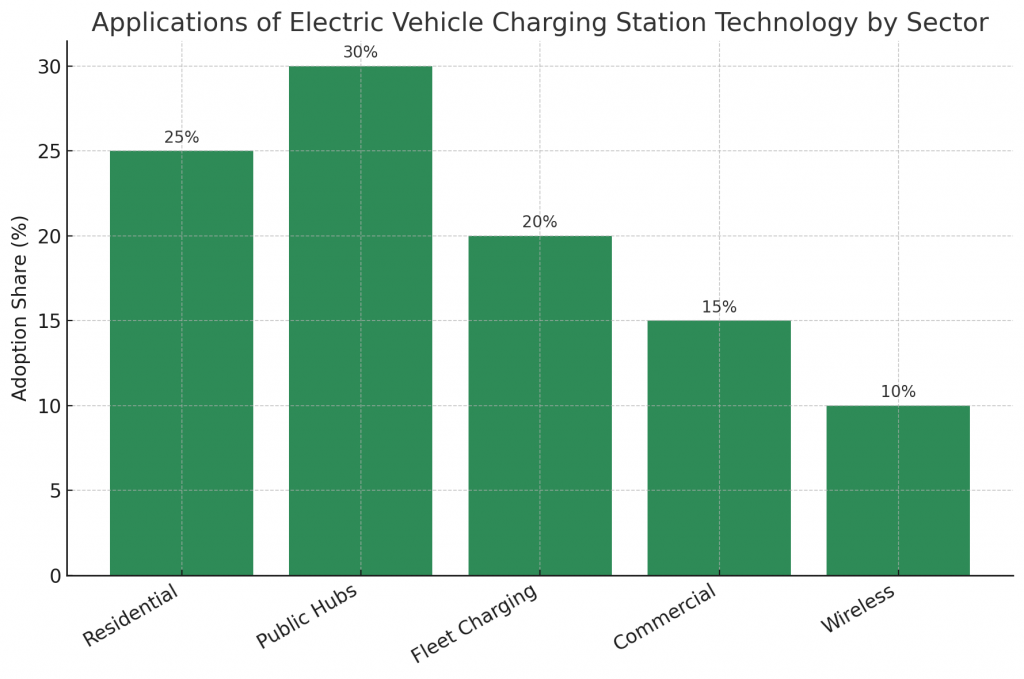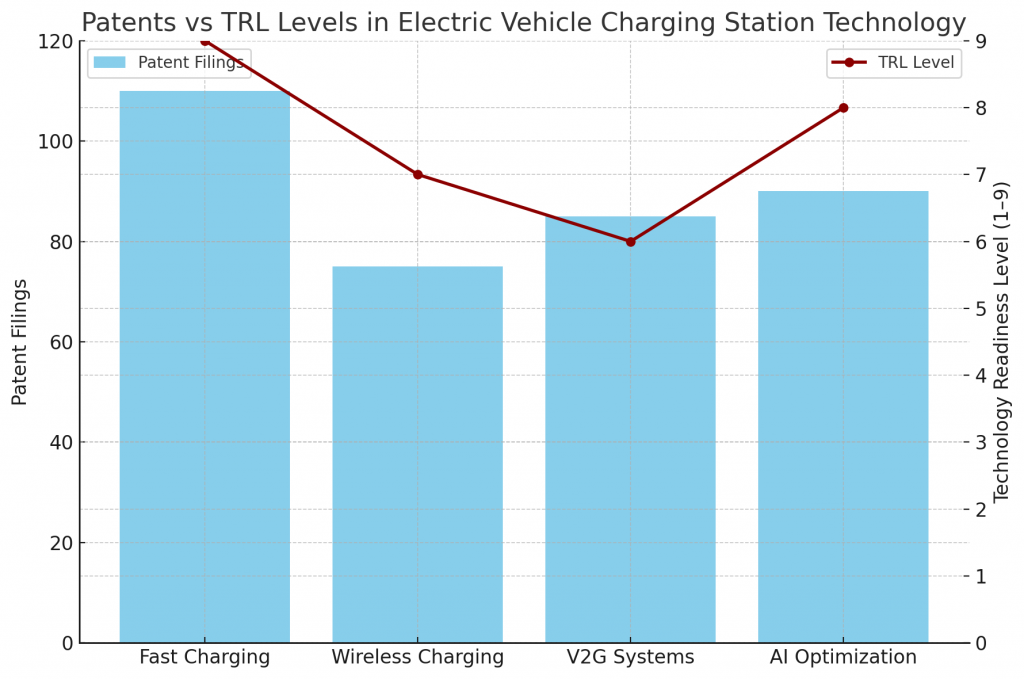The rapid rise of electric vehicles (EVs) is transforming global mobility. However, widespread adoption depends on one critical factor: charging infrastructure. At the heart of this transition is electric vehicle charging station technology, a field that blends hardware, software, energy systems, and connectivity to deliver efficient, reliable, and scalable charging solutions.
As governments, automakers, and energy providers push toward sustainable transport, electric vehicle charging station technology is emerging as the backbone of the clean mobility revolution. From fast charging innovations to smart grid integration, this technology ensures EV adoption accelerates without compromising convenience or sustainability.
What Is Electric Vehicle Charging Station Technology?
Electric vehicle charging station technology refers to the integrated systems enabling EV charging across residential, commercial, and public settings. It includes both the physical hardware and the digital platforms that manage electricity delivery.
Core components include:
- Charging hardware: Connectors, power converters, and charging ports.
- Software management: Apps and platforms for scheduling, billing, and monitoring.
- Energy integration: Smart grids and renewable sources feeding charging networks.
- Communication protocols: Standards like OCPP ensuring interoperability.
- Advanced models: Wireless charging pads and ultra-fast DC chargers.
This holistic approach ensures that EVs charge efficiently, safely, and sustainably.
Why Is Electric Vehicle Charging Station Technology Important?
The importance lies in enabling mass EV adoption. Without robust charging infrastructure, EV growth will stall.
Key reasons include:
- Consumer confidence: Accessible charging reduces range anxiety.
- Grid stability: Smart stations balance power loads during peak demand.
- Environmental impact: Integration with renewable energy cuts carbon footprints.
- Economic growth: Expanding charging networks creates jobs and investment opportunities.
- Urban planning: Charging hubs support sustainable cities.
Clearly, electric vehicle charging station technology is essential for scaling clean mobility.
How Does Electric Vehicle Charging Station Technology Work?
The process involves seamless integration of power delivery and data exchange:
- Step 1: Power conversion – AC from the grid is converted to DC for EV batteries.
- Step 2: Communication protocols – Vehicle and station exchange data to manage speed and safety.
- Step 3: Smart energy management – AI optimizes charging times to reduce peak demand.
- Step 4: User interface – Apps or RFID cards manage access and payments.
- Step 5: Grid integration – Stations connect with renewable energy and energy storage systems.
By blending engineering and intelligence, electric vehicle charging station technology ensures reliability and scalability.
What Are the Benefits of Electric Vehicle Charging Station Technology?
The benefits extend across industries and society:
- For consumers: Faster charging and seamless payments.
- For businesses: Revenue opportunities through charging services.
- For utilities: Grid stability and demand-side management.
- For governments: Cleaner air and reduced oil dependency.
- For the planet: Lower greenhouse gas emissions.
This makes electric vehicle charging station technology a driver of both environmental and economic progress.
What Are the Applications of Electric Vehicle Charging Station Technology?
Applications cover a broad range:
- Residential charging: Home-based stations for overnight charging.
- Public charging hubs: Fast-charging points in cities and highways.
- Fleet charging: Solutions for buses, taxis, and delivery fleets.
- Commercial charging: Offices, malls, and hotels providing charging as a service.
- Wireless charging: Emerging inductive charging for convenience.

These diverse applications highlight how electric vehicle charging station technology supports all aspects of mobility.
Which Companies Are Leading in Electric Vehicle Charging Station Technology?
Several global corporations dominate the field:
- Tesla Supercharger Network: Proprietary fast-charging solutions.
- ABB: Ultra-fast chargers and smart grid integration.
- Siemens: End-to-end EV infrastructure systems.
- ChargePoint: Extensive global charging network.
- BP Pulse & Shell Recharge: Energy giants expanding into EV infrastructure.
These leaders showcase how electric vehicle charging station technology is scaling globally.
Which Startups Are Innovating Rapidly?
Startups bring agility and disruptive ideas:
- EVBox: Smart charging solutions with global reach.
- Electrify America: Expanding ultra-fast charging across the U.S.
- IONITY: Joint venture delivering pan-European charging.
- WiTricity: Wireless EV charging pioneers.
- Blink Charging: Flexible business models for commercial spaces.
Together, they are accelerating adoption of electric vehicle charging station technology.
What Do Patents and TRL Levels Indicate?
Patent filings reveal innovation in:
- Wireless charging technologies.
- Smart charging algorithms.
- Vehicle-to-grid (V2G) systems.
- Ultra-fast DC chargers.
Technology Readiness Levels (TRLs):
- Fast charging systems: TRL 8–9, widely commercialized.
- Wireless charging pads: TRL 6–7, in pilot projects.
- V2G platforms: TRL 5–7, scaling globally.
- AI-driven energy optimization: TRL 6–8, in deployment.

These trends show strong maturity and continuous innovation.
What Are the Challenges in Adoption?
Challenges persist despite rapid progress:
- High infrastructure costs: Large investments required for rollout.
- Standardization issues: Multiple connector types create compatibility problems.
- Grid demand pressure: Rising EV adoption strains electricity supply.
- Urban space constraints: Difficulties in deploying public charging.
- Consumer behavior: Range anxiety and adoption resistance remain.
Addressing these hurdles will unlock the full potential of electric vehicle charging station technology.
What Is the Future Outlook?
The coming decade will redefine EV infrastructure:
- Short term (1–5 years): Expansion of fast-charging networks.
- Medium term (5–10 years): Large-scale adoption of V2G and AI optimization.
- Long term (10+ years): Wireless charging and energy-positive stations.
This future ensures electric vehicle charging station technology becomes a cornerstone of global transport systems.
How Can PatentsKart Help?
PatentsKart supports innovators in electric vehicle charging station technology with:
- Patent landscaping to identify white spaces.
- Freedom-to-operate analysis to reduce risks.
- Competitor benchmarking to track leaders and startups.
- TRL benchmarking to assess technology maturity.
- Licensing and partnerships to accelerate commercialization.
With these services, PatentsKart enables innovators to lead in the global EV revolution.
Conclusion
The world is shifting toward clean mobility, and electric vehicle charging station technology is the bridge making it possible. From smart grids to wireless charging, this field underpins EV adoption and sustainable cities.
By integrating innovation, infrastructure, and intelligence, charging technology is powering the mobility revolution. The future of transportation will be written not just on roads, but in charging networks connecting people, vehicles, and energy.
FAQs About Electric Vehicle Charging Station Technology
Q1. What is electric vehicle charging station technology?
It is the hardware and software enabling safe and efficient EV charging.
Q2. Why is it important?
It reduces range anxiety, supports sustainability, and enables EV adoption.
Q3. Which companies are leaders?
Tesla, ABB, Siemens, ChargePoint, BP Pulse, and Shell Recharge.
Q4. What are the challenges?
High costs, standardization issues, and grid strain.
Q5. How can PatentsKart help?
By providing patent insights, competitor analysis, and commercialization support.







